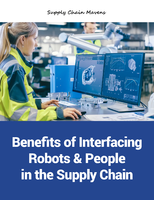AASHTO Report details transportation headaches and remedies.
Press Release Summary:
AASHTO and TRIP jointly released America's Top Five Transportation Headaches - and Their Remedies, which describes top transportation issues and ways to fix them, such as beginning work immediately, providing funding, and using advanced technology. States are prepared for projects supporting 1.8 million jobs, according to John Horsley, and William M. Wilkins of TRIP said fixing transportation problems will increase productivity and economic competitiveness.
Original Press Release:
Top Five Transportation Headaches and Remedies Identified
Washington, D.C., January 14, 2009 - A new report released jointly today by AASHTO and TRIP entitled "America's Top Five Transportation Headaches - and Their Remedies," identifies crumbling roads and bridges, growing traffic jams, crowded transit systems and rail cars, an unacceptably high rate of traffic crashes and fatalities, and insufficient funding as the top five transportation headaches ailing the nation.
The report also prescribes five remedies for the nation's transportation headaches, which include moving ahead with ready-to-go transportation construction projects; putting unemployed workers back on the job (particularly in the hard-hit construction sector); using the most cost-effective construction techniques and materials; and following a transportation investment strategy that will provide the nation with a transportation system that will improve mobility, safety, and the condition of roads, bridges, and transit systems throughout the nation.
"Fast relief for transportation headaches is one of the immediate benefits we can see from the economic recovery legislation being sought by President-elect Obama. States are ready to move thousands of ready-to-go highway projects that can support 1.8 million jobs," said Executive Director John Horsley. "Long-term, these transportation investments will build or preserve assets that will help the economy for years."
"Relieving our nation's transportation headaches will go a long way towards relieving the nation's economic headaches by creating jobs in the short and long-term and by increasing the nation's productivity and economic competitiveness," said William M. Wilkins, TRIP's executive director.
The top five transportation headaches are: Headache Number One: Aging and deteriorating roads, bridges, and transit systems. One-quarter of major urban roadways are in poor condition, 25 percent of the nation's bridges are structurally deficient or functionally obsolete, and roughly half of the nation's transit buses and rail cars have exceeded their service life or will do so within the next six years.
Headache Number Two: Congested roads, highways, and transit systems. The nation's roads, bridges, and transit systems are increasingly overburdened and congested, leading to quality of life and economic headaches in the form of longer rush hours, costly disruptions in freight movement, and overcrowded transit buses and rail cars.
Headache Number Three: Traffic fatalities and injuries. More than 41,000 lives were lost on the nation's roads in 2007. Although this is the lowest number of traffic fatalities in nearly 50 years, it is still unacceptable and can be further lowered by making needed roadway safety improvements.
Headache Number Four: Demand is stressing the system. Increasing demands on the transportation system, largely due to rising levels of population, travel, and economic activity, result in additional wear and tear on the our nation's roads, bridges, and public transit systems. Since 1990, U.S. population and vehicle travel increased by 41 percent, while transit travel has increased by the same level since 1995.
Headache Number Five: Everyone's costs are rising. Drivers are losing $249 billion each year as a result of travel on roads that are congested, deficient, or lack desirable safety features. The costs of materials used for road, highway, and bridge construction have increased by 55 percent over the last five years, further stretching the already thin and underfunded transportation budgets at the federal, state, and local level. The current level of national transportation investment would need to double in order to significantly improve the country's highway, transit, passenger rail, and freight systems.
Although there are significant challenges in providing Americans with a safe, well-maintained, efficient surface transportation system, sources of relief from transportation headaches are available. The top five transportation headache relievers are:
Remedy Number One: Begin work immediately on "ready-to-go" transportation projects. State transportation departments have 5,280 highway and bridge projects worth $64 billion that can be under contract within 180 days of the approval of additional funding. An additional 736 transit projects totaling $12.2 billion are ready to begin within 90 days if funding is made available.
Remedy Number Two: Boost transportation funding to stimulate economic growth in the short, medium, and long-term. Funding transportation improvements can support jobs and ease the high unemployment rate, particularly in the hard-hit construction sector. Every $1 billion invested in highway construction would support approximately 27,800 jobs, both in the construction sector and in non-construction related sectors of the economy.
Remedy Number Three: Recognize that the benefits of surface transportation improvements outweigh the costs. Every dollar invested in the nation's highway system yields $5.69 in economic benefits in reduced delays, improved safety, reduced emissions, and lower vehicle operating and maintenance costs. Similarly, each dollar invested in the nation's public transit system has been found to provide $6 in benefits in the form of time savings, parking and travel time savings, avoided job loss, avoided welfare payments, avoided vehicle crashes, avoided congestion and pollution, increased central city labor opportunities, increased mobility for people without access to private vehicles, and improved educational opportunities.
Remedy Number Four: Use innovation and advanced technology to build highway and bridge improvements that last longer, are environmentally savvy, and take less time. Transportation agencies and the private sector have made significant progress in developing highway and bridge designs, construction techniques, and materials that last longer and require less time for repairs.
Remedy Number Five: Make a down-payment on the nation's transportation needs immediately, and address long-term improvements in the near future. Immediate transportation infrastructure investment can play a significant role in hastening the nation's economic recovery. In addition, crafting a new long-range federal surface transportation program to replace the current program, which expires on September 30, 2009, provides an opportunity to set the nation on a course to achieving a safe, reliable, and well-maintained system of roads, highways, bridges, and public transit. Many comprehensive proposals have already been set forth that offer new ideas to meet the nation's transportation needs.
The American Association of State Highway and Transportation Officials (AASHTO) is the "Voice of Transportation" representing state departments of transportation in all 50 states, the District of Columbia, and Puerto Rico. AASHTO is a nonprofit, nonpartisan association serving as a catalyst for excellence in transportation.




